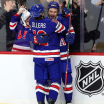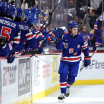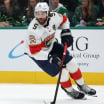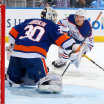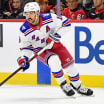The Senators thrive when they play within their structure through the neutral zone. They thrive by putting up a wall and not letting the opposition through. The Rangers didn't let them set up that wall in Game 3 and instead forced them to turn and go back to get the puck.
"In the other games, trying to get through the neutral zone, they would trap it up and we had one guy coming with speed, and that turns into a one-man forecheck and it's almost impossible to get the puck back with one man going," Nash said. "Tonight, it was like a five-man forecheck, the three forwards and the D were coming in. It just made it that much easier to retrieve the puck."
It caused chaos for the Senators, who didn't have enough players going back to get the puck because of their 1-3-1 setup. Ottawa goalie Craig Anderson tried to help out at times, but it turned into an adventure for him trying to play the puck.
Anderson was out of his net trying to play the puck when Grabner scored.
Beyond that, once the Rangers retrieved the puck, they had the Senators chasing them around the zone. The Rangers cycled well and dominated down low.
It was never more apparent than in the first period, when the Rangers had a 2-0 lead, a 15-5 advantage in shots on goal and a 26-12 edge in total shot attempts. The entire period was played at even strength.
"It was guys just realizing what works," Nash said.






